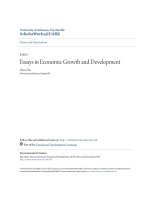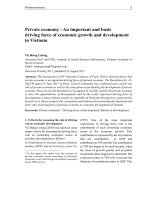Economic growth and economic development 401
Bạn đang xem bản rút gọn của tài liệu. Xem và tải ngay bản đầy đủ của tài liệu tại đây (154.3 KB, 1 trang )
Introduction to Modern Economic Growth
and thus c∗ do not depend on the instantaneous utility function u (·). The form of
the utility function only affects the transitional dynamics (which we will study next),
but has no impact on steady states. This is because the steady state is determined
by the modified golden rule. This result will not be true when there is technological
change, however.
8.5. Transitional Dynamics
Next, we can determine the transitional dynamics of this model. Recall that
transitional dynamics in the basic Solow model were given by a single differential
equation with an initial condition. This is no longer the case, since the equilibrium
is determined by two differential equations, repeated here for convenience:
k˙ (t) = f (k (t)) − (n + δ)k (t) − c (t)
(8.24)
and
1
c˙ (t)
=
(f 0 (k (t)) − δ − ρ) .
c (t)
εu (c (t))
Moreover, we have an initial condition k (0) > 0, also a boundary condition at
(8.25)
infinity, of the form
∙
µ Z t
ảá
0
lim k (t) exp
(f (k (s)) − n) ds
= 0.
t→∞
0
As we already discussed in the context of the q-theory of investment, this combination of an initial condition and a transversality condition is quite typical for
economic optimal control problems where we are trying to pin down the behavior
of both state and control variables. This means that we will again use the notion
of saddle-path stability introduced in Theorems 7.17 and 7.18 instead of those in
Theorems 2.4, 2.5 and 2.6. In particular, the consumption level (or equivalently
the costate variable µ) is the control variable, and its initial value c (0) (or equivalently µ (0)) is free. It has to adjust so as to satisfy the transversality condition
(the boundary condition at infinity). Since c (0) or µ (0) can jump to any value,
we again need that there exists a one-dimensional curve (manifold) tending to the
steady state. In fact, as in the q-theory of investment, if there were more than one
paths tending to the steady state, the equilibrium would be indeterminate, since
there would be multiple values of c(0) that could be consistent with equilibrium.
387









